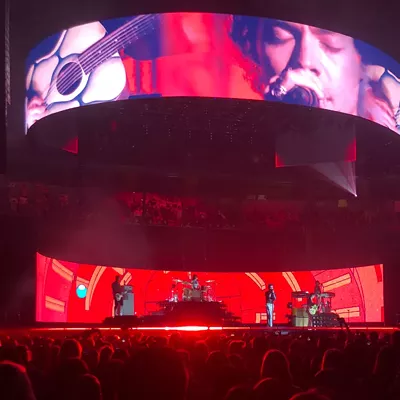Saturday, March 8, 2014
How True Detective — like other great TV shows — lays out its themes in the opening credits
One great thing about HBO: It has the power to let main titles languish, unfold at luxurious length. No hurry. Stay awhile. Bask in our storytelling.
And sometimes, those main titles, those opening credits, tell you absolutely everything you need to know about the type of show that follows them.
Before you read further, I want you to watch this intro video, even if you’ve seen it before. Watch it several times. Listen to the music. Concentrate on the images.
If you haven’t seen True Detective, know that the plot is nothing special: Marty Hart and Rust Cohle are two mismatched detectives investigating a grisly crime. One detective — curmudgeonly, hypocritical Marty Hart (Woody Harrelson) — is a type you’ve seen a thousand times before, though perhaps never played with so vividly and unsympathetically. And the other detective is a type we haven’t really seen before — a wiry, observant philosopher-king, prone to unspooling arcane and trippy monologues on the nature of life, the universe, everything.
Together, they investigate a grisly series of murders, as the show flashes back and forth from 1995 to 2012. Some on the internet have gone all Carrie Mathison searching for clues to solve the case.
But the case is beside the point. In fact, when the show starts concerning itself with plot — whodunnit? — that’s when it gets the weakest, ambition sagging into just another run-of-the-mill episode of CSI: Humid Trailer Park.
When its lens is satisfied to just explore the cracks and crags of these two leads, to navigate their environment — their physical, moral, existential environments — that’s when it becomes one of the best shows on television.
Watch those opening credits again. You don’t see much gore or violence or detective work, because the show isn’t about any of those things. Instead you see atmosphere.
True Detective is so soaked in atmosphere it drips with it like a sweat-sopped Sunday dress shirt.
You see decay and loneliness and dread. You can see it in the shot of Marty’s eyes, looking worried, even terrified, into the distance. You can hear that dread in the low voice and creeping music and dark lyrics in the opening credits’ song, Far from Any Road by The Handsome Family.
Hidden in the branches, of a poisoned creosote. Boiling sun. Fingers ran with blood. Looming shadows. Silver moon. Rattlesnakes unfold. Mountain cats will come to drag away your bones.
It’s ostensibly about a murder, like the central plot of True Detective. But it’s not about the actual act of the killing described: It’s the abandoned corpse, left to rot.
This is a song about a murder, yes. But it’s not about the act. It’s about the corpse. It’s about the passing of time, undiscovered as the body recedes into sand, and the bones are torn apart by wild creatures.
In this song, this is a desert of sand and heat and cacti and hissing snakes. It’s not exactly the marshy muck or oil-stained factories or the backwater backwoods of True Detective. Instead, the main titles give us what the show’s creator calls the “exhausted frontier.”
The oil-stained refinery. The church with peeling paint . The late night truck stop. The childless swing-set.
But the result is the same: These are empty, decaying places. They are, as the song is titled, “Far From Any Road.“
Most shows could illustrate loneliness with an abandoned landscape containing a solitary man. But here, in these credits, solitary men contain the abandoned landscapes. It’s internal devastation, wrought by a man’s mind instead of his circumstances.
A lot has been written about True Detective’s lack of developed female characters. It’s underscored by the main titles, where the woman are all largely reduced to bare flesh or unobtainable fantasy objects.
It’s a fair criticism, but the flat-secondary characters heighten the feeling of isolation the two leads feel. That’s especially true toward the end. Marty and Rust have nearly nothing but contempt left for each other. The eye rolls and muttered insults were just the beginning.
The credits set you up to be in the lonely shoes of Rust and Marty: He busted his lip, busted your taillight with your skull. You screwed his wife, but he’s only thing in your miserable husk of a life you have left. This isn’t an alliance of choice — it’s an alliance of what feel like the last two true detectives on the face of the earth.
There’s a tone of True Detective, painted all over the opening credits, that many critics have dubbed “existential dread.”
It’s a feeling almost captured by True Detective’s stylistic brothers: In the movie Se7en, the dread comes from the sense of pervasive evil — the world is a sick and sinful place, with a monster at the bottom of every box.
On NBC’s Hannibal, dread comes from the monsters, yes. But it also comes from the dread that, by fighting these monsters, by grappling with who they really are, they risk infecting you with their disease. It’s an expansion on Se7en’s final gut-punch punchline. On Hannibal, evil eats you up from the inside — if it doesn’t eat you up from the outside first.
True Detective has both: There are monsters so twisted that it sends a hardened cop like Marty retching. And there are hints of darkness growing, like, well, a poison creosote, in both Rust and Marty.
But the greatest source of dread on True Detective, I think, isn’t about evil it all. It’s the dread that comes with beholding one’s own wasted life, seeing all your hopes and ambitions withered, dried-up like a sun-bleached tobacco plant. Dried up like the bones in “Far From Any Road.”
Whether because of some damn fool accident or just because you’re a damn fool, you’ve blown apart everything that was good and beautiful and hopeful in your life.
It’s despair from regret, despair form self-immolation. Fire plays prominently in the main titles, licking across Marty’s face and Rust’s bare chest.
There’s some debate about whether Rust Cohle’s musings are profound, or a little like the sort of babble a philosophy major prattles on about at 3 am while sprawled across a beanbag chair. Like poetry, the difference between great philosophy and sophomore dreck is a thin one.
But I think it doesn’t matter. It matters because of what it tells you about Cohle. Rust’s flat-circular monologues and Marty’s drunk-on-masculinity fists do the same thing: Two ways of lashing out at despair. Nihilism and pugilism.
It’s why both have trouble resisting that fifth glass of whiskey. It’s why one repeatedly cheats on his beautiful wife; it’s why the other throws himself recklessly into biker-gang chaos on a hunch.
The main title sequence doesn’t “solve” True Detective. It’s not full of little clues that eagle-eyed Internet detectives can plug into their theory matrices. But it goes a phenomenal way to immediately proclaim and complement the show’s tone.
Here are a few other shows with great title sequences:
TRUE BLOOD
True Blood has a great title sequence, but one that promises a different sort of show, one centered around the intersection of sex and heat and religion fervor more than the pulpy vampire show actually delivers. Here, like Dexter, the greatness of the title is quickly undercut by the content of the show.
MAD MEN
I’m a huge fan of the Mad Men title sequence — especially after learning that you can sing “Mad Men, Mad Men, Mad Men, Mad Men” along with the music — but in latter seasons the show diverted into subtler, more complicated meanings than a man’s precarious position and his relationship in the advertising industry. And we still have yet to truly see the fall of Don Draper the sequence seems to predict.
HUMAN TARGET
A short-lived, pretty-good-in-its-first-season action show features a heroic theme from Battlestar Galactica composer Bear McCreary that recalls old action serials and movies like Indiana Jones, both references that set up the series nicely. It’s hummable, a rare feat for a TV score. The globe-trotting action-hero images have a hand-drawn, splotched ink feel, and work as a homage for a series inspired by a comic book.
CHUCK
Chuck’s a show about a nerds and spies — but they’re cool nerds and dorky spies. Drawing from Cake’s “Short Skirt and Long Jacket,” and sending the Buy More Nerd Herd silhouette through light-hearted feats of derring-do, told viewers Chuck was going to be fun, action-packed, and a little silly at times.
HOMELAND
This is a controversial one.
A jazzy haze of black and white images, Homeland includes speeches from world leaders like Barack Obama, Colin Powell, and George H.W. Bush, words in a foreign language, inverted black-and-white images, and iconic audio clips from the show itself: A plane crashed into the World Trade Center… you’re the smartest and the dumbest f—-in’ person I’ve ever known…
But it works because Homeland at its very best is about dual sources of haze: The haze of mental illness of CIA officer Carrie Mathison and the haze inherent to spycraft.
And in perhaps the best moment of the series, the trumpets of the title sequence begin to actually invade the show’s score itself toward the end of the first season. Carrie shrieks out warning, yelling about the truth, because but nobody believes her. Because she’s crazy and all that jazz is drowning out her words.
THE WIRE
The Wire begins with an almost impossibly narrow lens — essentially one case bathed in just-shy-of-impenetrable cops and gang jargon — but then pulls back on the zoom with each successive season. The unions. The politicians. The schools. The media.
Using a different cover of Tom Waits’ “Way Down In the Hole” for each season, The Wire shifts the focus.
COMMUNITY
The default of Community is a fairly bland sitcom credit intro. But for especially unusual episodes the credits themselves change with the theme: Halloweeny for Halloween episode, a Christmasy stop motion musical twist for a Christmas episode, Sergio Leone style for a paintball western episode, and Lord of the Ringsy for a Dungeons and Dragons episode.
Appropriate for the most ambitious, ever-changing sitcom on television.
GAME OF THRONES
In possibly the best title sequence on television, the camera flies over the map of Westeros, zooming in on individual cities that seem to be constructed with a series of whirring gears. Fitting, because on Game of Thrones geography determines fortunes, and the cogs of power are always turning, lifting one city above another and grinding up any who get in the way.
It’s also a show where a few mournful strings can set off a massacre — as the driving music in the background hints at.
The best part: the credits actually change as new cities are introduced and old ones are destroyed.
Tags: HBO; True Detective , TV , Image , Video



















